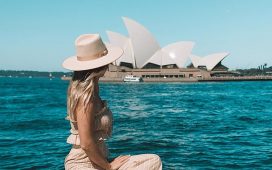Beto Diniz shook his head and turned the key to silence the quad-bike engine. “If we try and pass, the cart will go whoosh,” he said, with a gesture to illustrate the bike’s likely trajectory over the cliff on to the rocky beach below.
My flight to São Jorge had found a hole in the storm, but on this, the final leg of my journey, the weather had caught up with me. On the island’s steep northern slopes, a torrential downpour had kick-started the cataracts, one of which was now gushing with tremendous ferocity across the mud road. Diniz said he’d bring my bag when the torrent had subsided. And so, for the final mile, I walked.
The Azores, a Portuguese archipelago in the mid-Atlantic, is made up of nine main islands. São Jorge, in the central group, is one of the less visited: while the Azores received a record 1.17mn visitors last year, São Jorge had fewer than 30,000. With no direct flights to the European mainland, I flew in last month via the neighbouring island of Terceira.
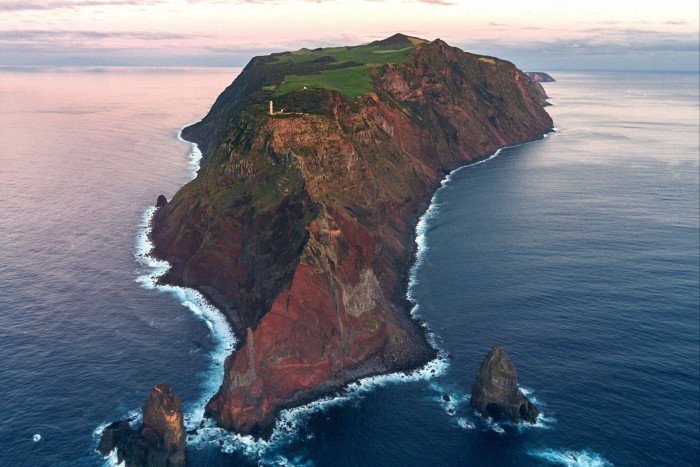
But while São Jorge is relatively anonymous, it is also arguably the most charismatic rock in the archipelago. A basalt shard, 55km long by 8km wide, it cants north-west to south-east, tapering into points like a Neolithic dagger. Even from the plane looking through the fog, I had been able to discern its dramatic, volcanic topography. Sheer flanks, draped in evergreen forest, tumbled out of the clouds and fell straight to the ocean.
Dotted at the foot of the slopes were fajãs, a feature across the Azores but especially common here: small, flat areas of land, formed by landslides and lava flows, that protrude into the sea. Highly fertile, they are usually covered with small fields.
On the ground a few hours later, I left the quad-bike and took a footpath that circumvented the thundering waterfall. I’d been walking for 20 minutes when one of these coastal plateaus came into view. On a tongue of black basalt was a collection of terracotta-roofed houses all built from the same volcanic stone. In the largest house, Nuno Ferreira was waiting with a bottle of Portuguese red, a wedge of São Jorge’s piquant cheese, and the story of how he built his personal Eden.
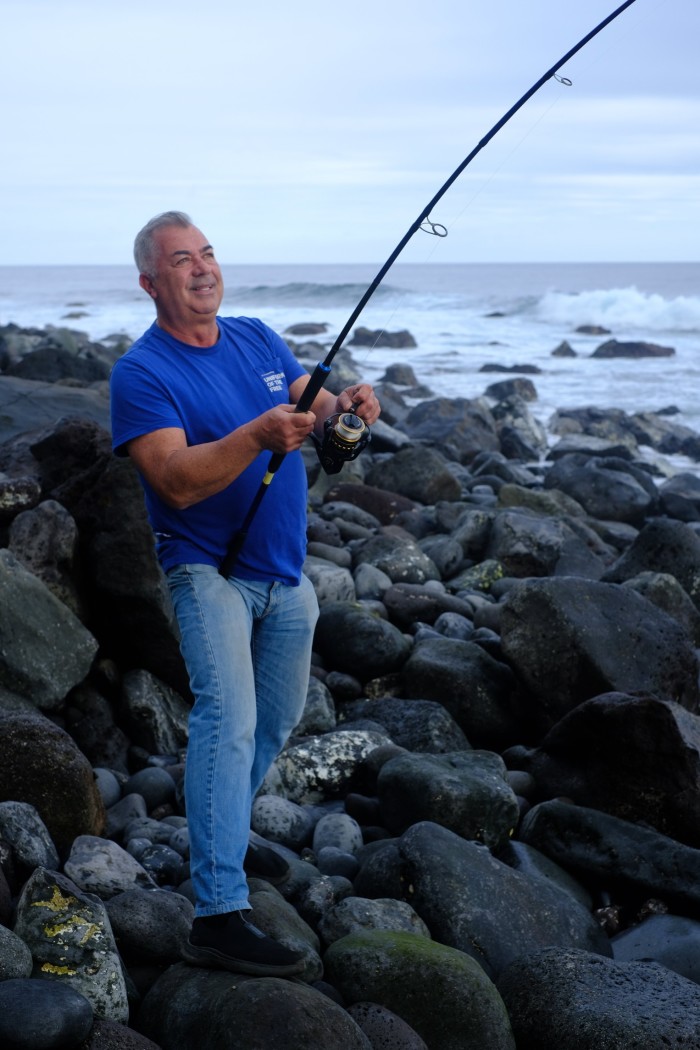
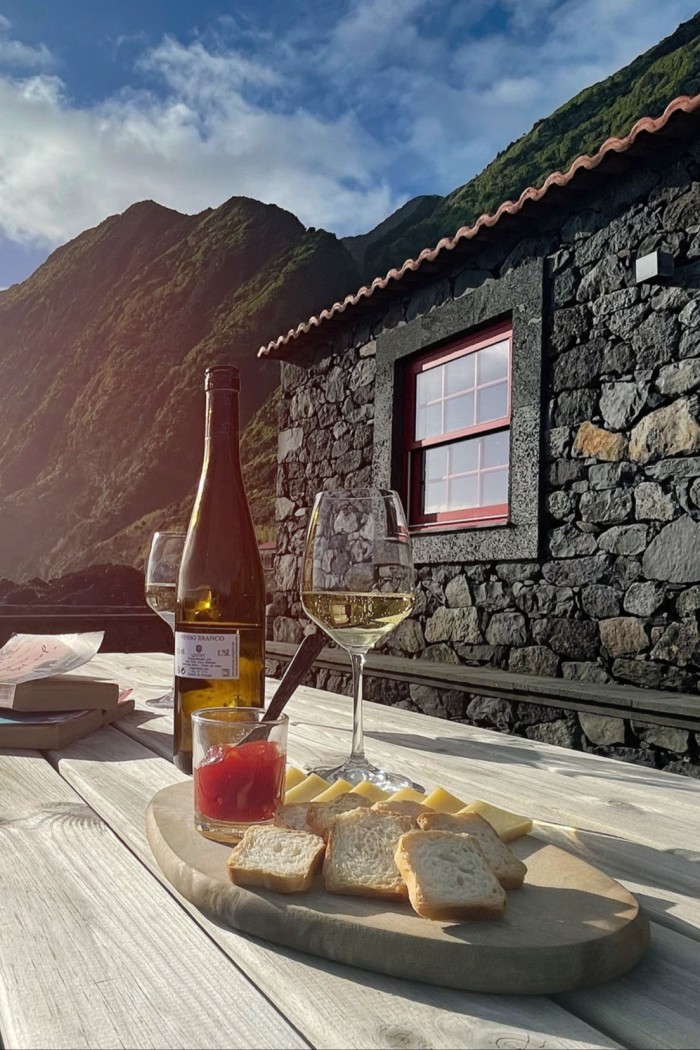
A stout 56-year-old, with close-cropped hair and a roguish humour, Ferreira had made his fortune in his native Angola, weathering the country’s turbulent politics to establish an advertising empire. His first visit to São Jorge was in 2018, a holiday with his wife Susan and their three children. A couple of days in, on a walk along the spectacular north coast, they came across a small fajã, and a hamlet of crumbling stone houses enveloped by the undergrowth.
Kicking through the ruins, Ferreira noticed a “for sale” sign attached to a dilapidated wall, including a phone number with the last digit scratched off. On impulse, he started dialling numbers, trialling the missing digit from one to nine. On eight, he got a ring. The owner was an elderly man living on Terceira. And, yes, the plot was for sale.
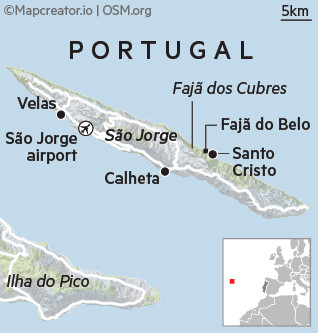
The spot was called Fajã do Belo. Parish records suggest it was named after Diogo Nunes Belo, a 17th-century settler. For centuries thereafter a handful of families had lived here, farming beans and sweet potatoes in the rich soil, which they further improved with Sargasso seaweed gathered from the shore.
This simple existence ended on New Year’s Day 1980, when an earthquake reduced the village to rubble. With this it was abandoned, its inhabitants scattered across the archipelago and around the world. Several relocated to Hawaii, where the lush, volcanic landscape was reminiscent of the home they’d left behind. Soon Ferreira had tracked down owners of a dozen of the houses. By the end of his month-long holiday, a construction team was already breaking ground.
During the Covid-19 pandemic, Ferreira’s contractors collected the stones from the collapsed buildings, forming an enormous pile on the beach. Masons then reshaped them to build robust walls, following the footprints of the original dwellings. “When we finished there were just five stones left over. It all felt predestined,” Ferreira said.
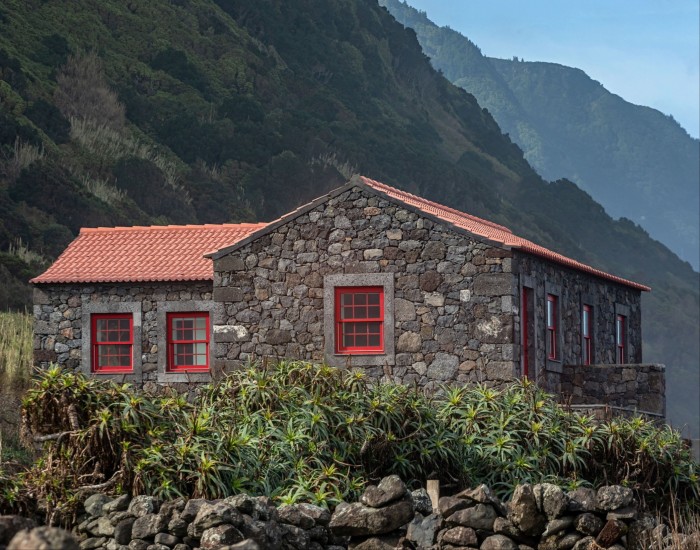
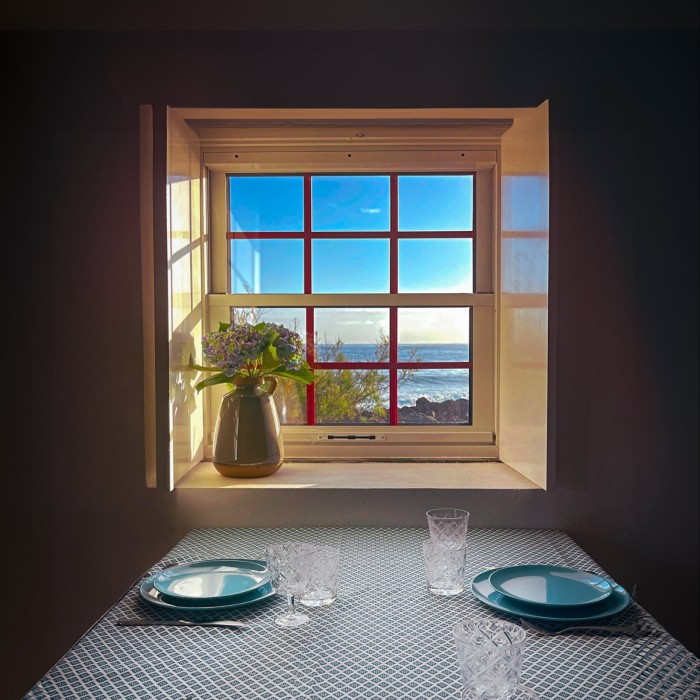
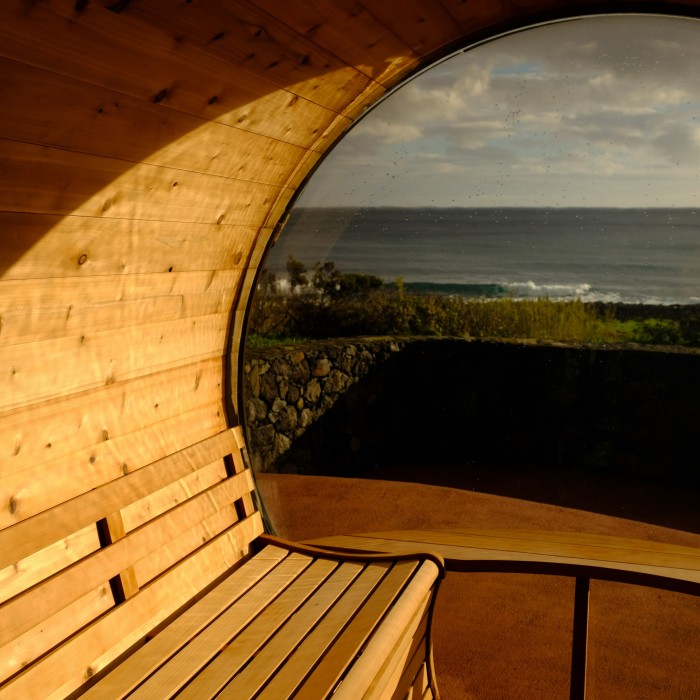
Fajã do Belo lodge is in many ways a homage to the village it supplanted. Inside, the houses are modern and spacious, but the exteriors could have been chiselled out of the ground itself. There are two small swimming pools, and a wooden sauna with views over the ocean. Guests come to hike and fish, and to surf on what are often world-class breaks offshore. But its greatest asset is its extraordinary isolation.
Since opening in late 2022, it has played host to Portuguese pop stars, footballers and politicians. Diniz, the lodge manager, spends much of his time on the all-terrain buggy carrying guests and supplies along the narrow track that is the only route in.
Despite the drama of my arrival, visiting other parts of the island during my five-day trip was easy. Paulo and Paula Silva, husband and wife taxi drivers from Fajã do Ouvidor, two fajãs west of Belo, met me at the bottom of the dirt road for excursions across the island.
It quickly became apparent that the landscapes of São Jorge are demarcated by its spine. After climbing the wild north wall, the road emerged on to a plateau of cow pastures. The south side, where the slope is more sheltered and less severe, is home to most of the island’s 9,000-strong population, more than half of whom live in Velas, the soporific capital.
This more serene face of the island had diversions in common with other Azorean destinations. There were small Baroque churches and natural swimming pools, and family restaurants serving grilled fish straight from the sea. Trails wound through picturesque nature reserves burgeoning with dragon trees, azaleas and tree ferns.
But the atmosphere was also stubbornly parochial. Today, the main industry on São Jorge is dairy, and cows outnumber the human population by three to one. By the dock in Calheta, the island’s second town, decorators and electricians were putting the finishing touches to the new Museo Francisco de Lacerda. Housed in a disused tuna cannery, it features exhibition spaces devoted to local ethnography, and one to the museum’s namesake, Lacerda, a São Jorge native who went on to achieve fame as a composer and musicologist in Paris.
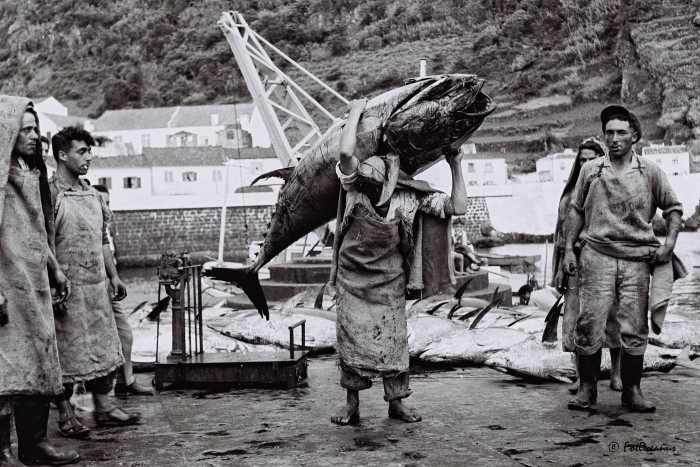
But the most enthralling gallery recalls the building’s old incarnation. In the 1960s, with the whaling industry in terminal decline, Portugal’s authoritarian Salazar government sought to industrialise tuna.
“The locals didn’t get it at first — why would you can tuna when you could just eat it fresh from the ocean?” said museum curator Alexandra Gomez, who’d agreed to give me an advance tour. But the canning made it easier to sell the product abroad; the Calheta cannery was named Marie D’Anjou, a nod to France, the principal export market.
Out on the ocean, the work began with the netting of blue jack mackerel. At the tuna grounds, the boats released the mackerel back into the water as live bait. As predatory fish gathered, the crews would use bamboo fishing rods to catch and reel them in — the bluefins weighing up to 300kg — then yank them aboard with yard-long hooks.
The Anjou factory was mostly staffed by women and girls, who would cut, cook, sort and can. On one wall of the exhibition, a testimony from a former worker recalled that she earned one escudo an hour. It was nevertheless a crucial step in the path of female emancipation — “the first time any women on the island would have earned their own money”, Gomez said.
Yet the advent of this thriving export industry did little to dispel São Jorge’s insularity. Gomez told me that her grandfather-in-law lived into his nineties and never left the island, only ever travelling from his home village of Vimes to attend the births of his 16 children, and to cart fish across to the north coast, which he would barter for potatoes. On these latter journeys, I wondered whether he may also have stopped to relish the views.
For the next few days, chiaroscuro clouds swirled about the northern fajãs, and I began to understand what the Portuguese writer Raul Brandão, in his celebrated 1926 history of the Azores, The Unknown Islands, had meant when he described São Jorge as a place of “dust and dream”.
At times the weather seemed a kind of alchemy. Light shows played over the ocean, transmuting the water from a seething plain of whitecaps to glassy smooth in the space of an hour. The north wall was lined with waterfalls. Some ran constantly, fed by inland springs. Others, like the torrent that had intercepted my arrival, were sporadic, evaporating to a trickle during dry spells and reappearing after heavy rain.
One morning, when the fog had lifted from the plateau, I caught a ride up to Serra do Topo, and the start of a walking trail that descended through a cleft in the northern slope. The path tunnelled through twisted junipers glistening with condensation, and a stream tumbled alongside in a series of pretty cascades.
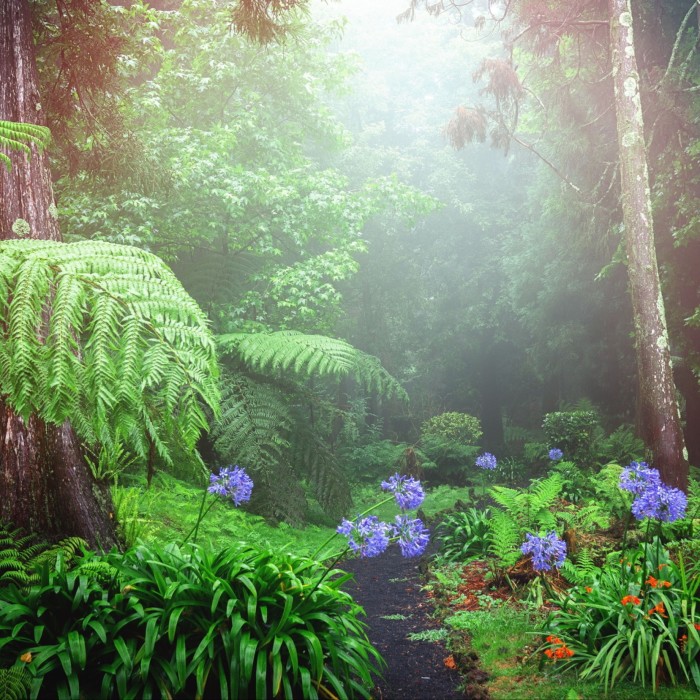
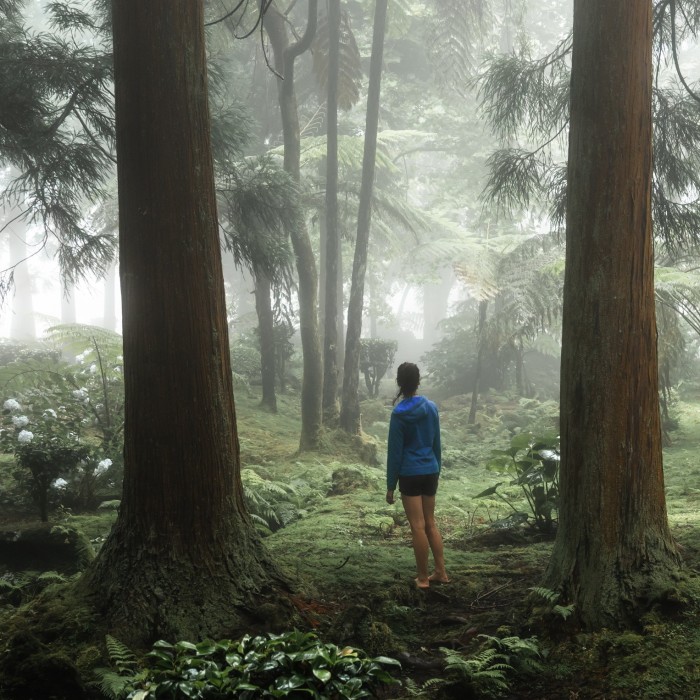

The path bottomed out at the village of Santo Cristo, one fajã east of Belo, where a five-metre-high levee, the lip of an ancient caldera, formed a coastal lagoon. A rainbow materialised over the church on the headland, and the lagoon calmed into a glassy sheet that mirrored the sky. The village itself was eerily quiet. Of the three families licensed to harvest the lagoon’s clams, a local delicacy, there was no sign.
Later, when I spoke to some locals at a bar in Fajã dos Cubres, one of them counted off Santo Cristo’s year-round residents on his fingers, stopping at six. In summer, the small influx of tourists reanimates the village, he added. But I felt privileged to be there in late spring, when the northern reaches felt so wild and liminal.
In the evening, back at Fajã do Belo, fruit bats darted in wobbly ellipses, and Cory’s shearwaters emitted their bizarre chatter from the coastal shrubs. In summer, Ferreira said, the abundance of birds, migrating here from as far afield as Polynesia, would make the cliffs resound “like a symphony”.
Also staying at the lodge was Baptiste Caulonque, the French chief executive of Pegasus, a US travel company that is partnering with Belo to promote its potential as a surf destination.
Just 250 metres out to sea, the bedrock falls away by more than two vertical kilometres. When Atlantic rollers hit this shelf at the right angle, the breaks could be supreme, Caulonque, a keen surfer himself, explained.
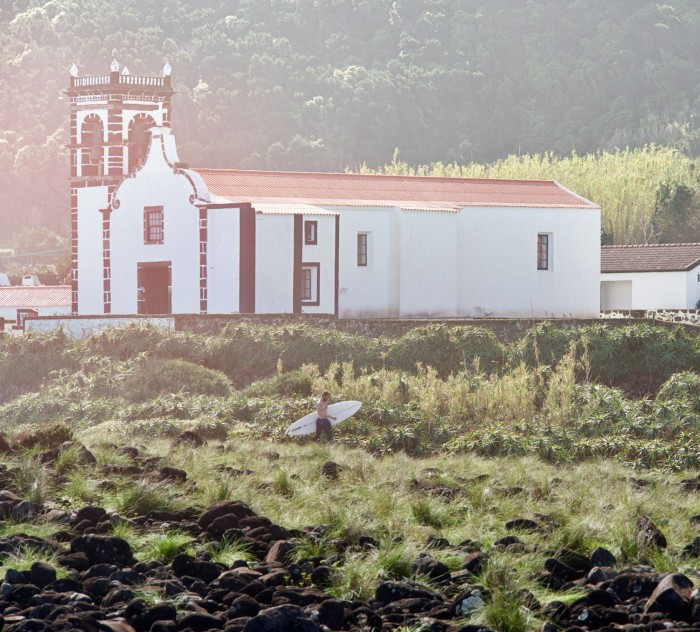
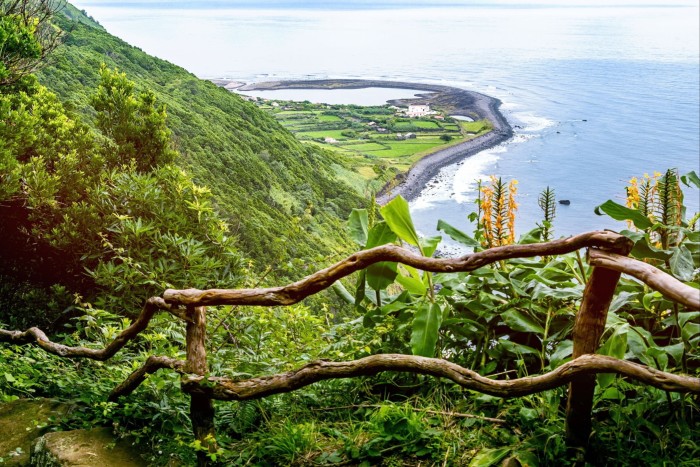
This time, though, he’d been left frustrated. For the duration of his stay, the swell refused to resolve into the waves he craved. But he remained philosophical; he knew full well that trips to São Jorge required a degree of fatalism.
On his first visit to Belo, last October, he’d arrived just ahead of a storm and ended up having the lodge to himself. With flights grounded, the colleagues he was due to meet were stranded elsewhere in the archipelago. Caulonque spent four days living “under the dictatorship of nature”, as gale-force winds hammered the beach.
When the storm’s eye passed overhead, he went outside to watch humpback whales, among the thousands of cetaceans that pass through here between April and October, breaching just offshore. “It was an intense introduction, but I was never worried,” Caulonque told me. All the while, Fajã do Belo’s stone houses felt rooted to the ground.
On our last morning, Caulonque donned his wetsuit and plunged into the sea for a compensatory swim. Too wimpish to join him, I wandered along the beach, hopping between the black boulders. A stone’s throw from the lodge, a skiff lay askew, fraying around the gunwales.
The boat had washed up two years ago, Ferreira told me. Subsequent inquiries found that it was registered to North Carolina, 4,000km away. Investigators were still trying to find out what had happened to its occupants, though it seemed likely that they had perished in a storm.
It was a macabre ornament, albeit an appropriate one. For all the comfort of Fajã do Belo, this is a place where the human presence cannot help but defer to the tumultuous nature that encircles it. “I am happy to just leave it here,” Ferreira said of the wreck. “It’s part of the fajã’s story now.” As is he.
Details
Henry Wismayer was a guest of Kuanza (fajadobelokuanza.pt) and Pegasus Lodges (pegasuslodges.com). Fajã do Belo’s self-catering houses sleeping two cost from €170 per night; family houses sleeping up to six start from €230 per night. Visitors can reach São Jorge with Azores Airlines (azoresairlines.pt), usually via Terceira or Ponta Delgada. Most flights to Terceira and Ponta Delgada originate in Lisbon, though direct services from London to Ponta Delgada are occasionally available in the summer months with Azores Airlines and Ryanair. São Jorge is also served by ferry from several of the neighbouring islands (atlanticoline.pt)
Find out about our latest stories first — follow FT Weekend on Instagram and X, and subscribe to our podcast Life & Art wherever you listen

